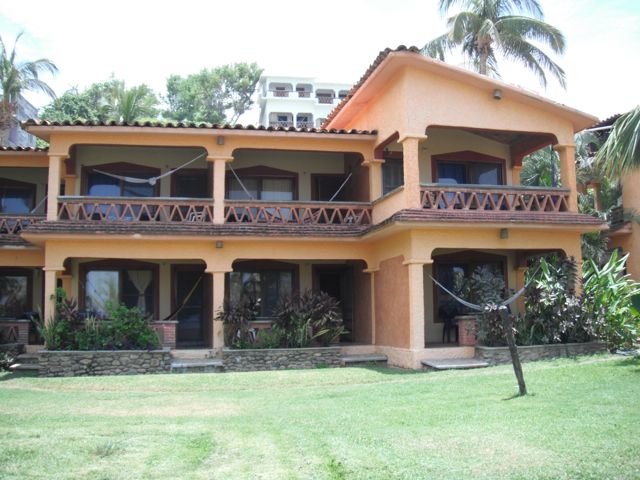A Tale of Two Hotels: The Santa Fe and the Arcoiris, where Zicatela’s tourist industry began
The Santa Fe
Imagine Zicatela in 1975. There’s a pig farm where Merlin’s now is and cows and goats forage on the beach, which was then covered with huizache. (In a still controversial move, the native vegetation was cleared by the state deputy in 1985.) A brickyard stands just beyond the rocks that separate Playa Marinero from Zicatela, and the beach extends all the way up to the highway. The owner of the brickyard is the former custom’s agent from the time when coffee was shipped from Puerto Escondido to the U.S. Imagine having the opportunity to buy that brickyard and its adjacent land.
Robin Cleaver was in the import business back then, buying Mexican folk art for his shop in Palo Alto, California. At the urging of his suppliers from Ocotlán, Olegario y Oralia Mendoza, one day he hopped onto a DC 3 and alighted on the airstrip - now Blvd Benito Juárez - in Rinconada. Being only human, he fell in love with the place.
Robin calls it serendipity. It seems so improbable that a person from Palo Alto just happened to know Dora Martínez, who had a vegetarian restaurant in Oaxaca and was also the goddaughter of Nacho Acevedo, the excustom’s agent. Knowing Robin’s affinity for Puerto, she told him when the Zicatela property was for sale. Thus it happened that a young man, with no plans beyond buying Mexican art for his shop, came to build Puerto’s first 4-star hotel.
After forming a Mexican corporation with his Mexican associates to purchase the land, the next step was finding investors and partners to build the hotel. From the start Robin knew he could count on his brother Paul to manage the hotel and vegetarian restaurant, since Paul Cleaver is, in his brother’s words, “a great host and cook” and as gregarious as his brother is low-keyed. Paul Cleaver has since moved on to his own hotel, El Tabuchín, located just behind the Santa Fe, which is equally famous for its gourmet breakfasts and its owner’s hospitality.
When construction on the Santa Fe started in 1981, all of Puerto’s tourist facilities were centered on Playa Principal. The accommodations were fairly basic, and there were no vegetarian restaurants, a problem for Cleaver who has been a vegetarian all his adult life. The other hotel owners were welcoming, but they thought he was making a big mistake building so far away. Not only did the calle del Morro not exist then, but there wasn’t even a dirt road down from the highway to Zicatela.
The plan was to begin with 22 of a projected 67 rooms, but the Mexican economic crisis of 1982 and its attendant devaluations forced Cleaver to scale back, and it was a ten-room hotel that opened its doors in December, 1982. The first guests were in their rooms before the windows were installed and the power connected, which turned out not to be a problem, because they said they preferred candles to electric lights.
Today the Santa Fe is the gracious grand dame at the entrance to Zicatela, with 60 rooms, two pools, and a gourmet vegetarian and seafood restaurant. It even has a gift shop that features Mexican folk art.
Hotel Arcoiris
In 1984, José Luis Mendiola was a civil engineer working on oil platforms and pipelines in Veracruz with dreams of leaving the petroleum business and dedicating himself full-time to his cattle ranch. His closest friends were the Americans he was working with and they were surfers who flew to Puerto Escondido whenever they could. José Luis was not a surfer, but he agreed to accompany them on one of their trips.
The American engineers wanted to open a hotel on Zicatela, and they wanted José Luis to be their partner. A meeting was held in San Antonio, Texas to put together a partnership. José Luis remembers that he proposed that they first share some tequila, then they shook hands to finalize the deal. And that is how the would-be cattle rancher came to run a hotel in Puerto Escondido.
The partners bought the land for the Arcoiris from a man who had purchased it from the land trust of Puerto Escondido (FIPE) – the state entity that had been set up as part of the 1970 federal expropriation of the area. But when they were ready to build, they found that their property had been divided into four lots that were claimed by people from Colotepec. (The municipio of Santa María Colotepec has never recognized the part of the expropriation that extends from Playa Principal to the Punta.) It took a year to iron out the conflicting claims to everyone’s satisfaction.
Then there was the question of seismic preparedness. José Luis remembers arguing with his partners over an architectural plan that did not seem appropriate for Oaxaca’s shaky ground. Then came the devastating 8.0 Mexico City earthquake in September of 1985 and with it the realization that the design had to change. At this point, all but one of the partners, Robert Crowe, abandoned the project.
The original plan called for 24 rooms, but the financial situation of the mid-80s was such that only eight were built when the hotel opened in 1986. Actually, the Arcoiris never had an official opening, since guests started moving in when it was just a bare cement construction. As José Luis tells it, surfers on Zicatela needed a safe place to keep their gear and didn’t mind sleeping on the floor or sharing a communal bathroom. The restaurant started with a cooler which operated on the honor system. These first guests also helped out by planting the hotel’s banana and papaya trees. The hotel was finally finished in 1989.
As is the case with many of Puerto’s hotels, besides attracting young surfers, the Arcoiris also has counted on retirees from Canada and the north of the U.S. who have been coming every winter for the last twenty years, some staying as long as five months. Nonetheless, the last five years have been hard for the hotels, with the international economic crisis and the demise of Mexicana airlines.
José Luis notes that there are fewer international tourists, and those who come don’t stay as long as they used to. On the other hand, the Arcoiris now hosts students from Norway through a university program in which the young people take courses from Norwegian professors on a semester abroad on Zicatela.













